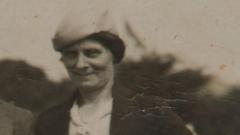Is the UK's Oldest Cold Case Finally Solved with a Murder Conviction?

The Unraveling of a Cold Case: The Conviction of a 92-Year-Old Man for the Murder of Louisa Dunne
In a remarkable turn of events, a 92-year-old man has been found guilty of the rape and murder of Louisa Dunne, a case that remained unsolved for nearly six decades. This shocking revelation has not only brought closure to the family of the victim but also showcased the efficacy of modern forensic techniques in solving cold cases. The story of Louisa Dunne and the conviction of Ryland Headley have captivated the public and reignited discussions about crime resolution, justice, and the advances in investigative procedures.
The Background of the Case
Louisa Dunne was a 75-year-old woman living in Easton, Bristol, when her life was tragically cut short. On June 28, 1967, she was discovered strangled on her living room floor by a concerned neighbor. The immediate aftermath of her death was shrouded in mystery, and despite extensive investigations, the case went cold. With no suspects and little evidence, it seemed that justice for Louisa Dunne would never be served.
Throughout the years, the case remained a haunting reminder of unsolved crimes. Family members and friends of Dunne were left grappling with her violent death and the lack of answers. However, the story took a pivotal turn in 2023 when a renewed investigation into the case uncovered new DNA evidence that would link the crime to a convicted rapist.
Who is Ryland Headley?
Ryland Headley, a resident of Clarence Road in Ipswich, was in his 30s at the time of the murder. His criminal history includes multiple convictions for sexual offenses, raising concerns about his predatory behavior. During the trial at Bristol Crown Court, it was revealed that Headley's previous crimes bore striking similarities to the method used in the murder of Louisa Dunne.
Detective Inspector Dave Marchant, the senior investigating officer on the case, described Headley as "predatory," emphasizing the chilling nature of his previous offenses. The overlap between Headley’s past crimes and the circumstances surrounding Dunne’s death led investigators to revisit the cold case with fresh eyes and advanced forensic techniques.
The Role of DNA Evidence in Solving Cold Cases
The breakthrough in the Dunne case can be largely attributed to advancements in DNA technology. In recent years, forensic science has made significant strides, allowing investigators to extract and analyze DNA from crime scenes even decades later. This was crucial in linking Headley to the murder, as new DNA evidence was pivotal in establishing a connection that had eluded law enforcement for years.
Detective Inspector Marchant remarked on the importance of combining traditional investigative methods with modern scientific techniques: "This is a marrying of old school and new school policing techniques." This blend has not only rejuvenated old cases but also demonstrated the potential for justice, even in seemingly hopeless situations.
The Impact of the Verdict
The conviction of Ryland Headley has sent shockwaves through the Bristol community and beyond. For the family of Louisa Dunne, it brings a sense of closure after decades of uncertainty. The emotional toll of losing a loved one in such a violent manner can be devastating, and the reopening of wounds is often a painful process. However, this verdict may offer a glimmer of solace, knowing that the perpetrator has been brought to justice.
Moreover, the case has sparked conversations surrounding cold cases in general. Many families continue to live with the pain of unsolved crimes, and the successful resolution of the Dunne case highlights the importance of continuous effort in seeking justice. It serves as a reminder that no case is truly closed until all avenues have been explored.
Public Reaction and Media Coverage
The media coverage surrounding the trial has been extensive, capturing the public's attention. The narrative of a 92-year-old man being convicted of such heinous crimes raises numerous questions about justice, age, and the legal system's treatment of elderly offenders. The case has dominated local news outlets, with discussions about the implications of the verdict and the methodologies used in solving cold cases.
Social media platforms have also been abuzz with reactions, as the public grapples with the complexities of the case. The story of Louisa Dunne has resonated with many, prompting discussions about the safety of communities and the effectiveness of law enforcement in solving crimes. The emotional weight of the case has ignited a call for continued attention to cold cases, urging authorities to invest in technology that can aid in resolving these longstanding mysteries.
Broader Implications for Law Enforcement
The resolution of the Dunne case has broader implications for law enforcement agencies across the UK and beyond. It underscores the need for ongoing training and investment in forensic science to ensure that cold cases are not relegated to the archives. This case has the potential to inspire similar reviews of unsolved cases, encouraging police departments to utilize modern techniques to revisit and resolve crimes that have remained dormant.
Furthermore, the Dunne case illustrates the importance of collaboration between law enforcement agencies and forensic specialists. By working together and sharing information, investigators can maximize their chances of solving cold cases and delivering justice to victims and their families.
Conclusion: A New Era of Cold Case Investigations
The conviction of Ryland Headley for the rape and murder of Louisa Dunne marks a significant milestone not only for the Dunne family but for the entire community of Bristol. It serves as a compelling example of how advancements in technology can breathe new life into cold cases, bringing hope to families who have long awaited answers. As law enforcement continues to embrace modern investigative techniques, the possibility of solving cold cases becomes increasingly plausible.
While the verdict brings closure, it also opens the door for continued dialogue about justice, safety, and the importance of never giving up on seeking truth. As we move forward, it is essential to remember that behind every cold case lies a story, a victim, and a family yearning for justice.
Frequently Asked Questions
What advancements in technology helped solve the Dunne case?
Modern DNA analysis techniques allowed investigators to extract and analyze DNA from the crime scene, ultimately linking Ryland Headley to the murder.
What was Ryland Headley’s criminal history prior to the conviction?
Headley had multiple convictions for sexual offenses, which raised concerns about his predatory behavior and linked him to the murder of Louisa Dunne.
How does the resolution of this case impact other cold cases?
The successful resolution of the Dunne case highlights the potential for solving other cold cases using modern forensic techniques, encouraging law enforcement to revisit unsolved crimes.
The story of Louisa Dunne is a poignant reminder that justice can prevail, even after many years. It's vital for families of victims to know that the quest for truth and closure can continue indefinitely. How do you think advancements in forensic technology will shape the future of criminal investigations? #ColdCaseJustice #ForensicScience #TrueCrime
Published: 2025-06-30 13:48:06 | Category: technology



